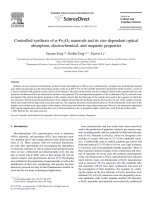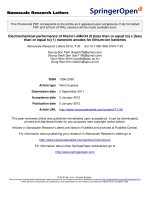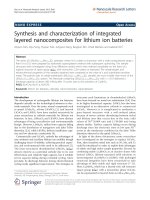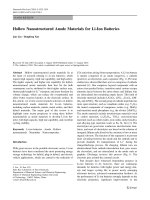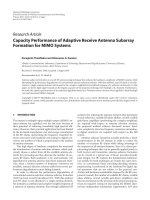- Trang chủ >>
- Khoa Học Tự Nhiên >>
- Vật lý
electrochemical performance of - fe2o3 nanorods as anode material for lithium - ion cells
Bạn đang xem bản rút gọn của tài liệu. Xem và tải ngay bản đầy đủ của tài liệu tại đây (870.57 KB, 4 trang )
Electrochimica Acta 54 (2009) 1733–1736
Contents lists available at ScienceDirect
Electrochimica Acta
journal homepage: www.elsevier.com/locate/electacta
Electrochemical performance of ␣-Fe
2
O
3
nanorods as anode material for
lithium-ion cells
Hao Liu, Guoxiu Wang
∗
, Jinsoo Park, Jiazhao Wang, Huakun Liu, Chao Zhang
School of Mechanical, Materials and Mechatronic Engineering, and Institute for Superconducting and Electronic Materials, University of Wollongong,
New South Wales 2522, Australia
article info
Article history:
Received 14 July 2008
Received in revised form
25 September 2008
Accepted 30 September 2008
Available online 17 October 2008
Keywords:
␣-Fe
2
O
3
nanorods
One-dimensional structure
Anode material
Lithium ion batteries
abstract
␣-Fe
2
O
3
nanorods were synthesized by a facile hydrothermal method. The as-prepared ␣-Fe
2
O
3
nanorods
have a high quality crystalline nanostructure with diameters in the range of 60–80 nm and lengths
extending from 300 to 500 nm. The cr ystal structure of the ␣-Fe
2
O
3
nanorods was characterized by X-
ray diffraction (XRD), scanning electron microscopy (SEM) and transmission electron microscopy (TEM).
The ␣-Fe
2
O
3
nanorod anodes exhibit a stable specific capacity of 800 mAh/g. This indicates significantly
improved electrochemical performance in lithium-ion cells, compared to that of commercial microcrys-
talline ␣-Fe
2
O
3
powders.
© 2008 Elsevier Ltd. All rights reserved.
1. Introduction
Due to its low cost and the abundance of its raw materials in
nature, Fe
2
O
3
has been widely investigated in many technological
fields for applications such as energy materials for lithium ion stor-
age, gas sensors, catalysts, and magnetic applications [1–6].Itis
well known that the particle sizes and shapes of nanoscale materi-
als affect their properties and potential applications. Iron oxides
have been synthesized in a variety of morphologies, including
nanoparticles [7,8], nanowires [9,10], nanorods [4,11,12], nanotubes
[13,14], nanoflakes [15], and novel core-shell structures [16].
Many transition metal oxides have been investigated as anode
materials for lithium ion batteries [17,18]. The Fe
2
O
3
crystal lattice
can store six Li ions per formula unit, and the theoretical capac-
ity of Fe
2
O
3
is as high as 1005 mAh/g, which is much higher than
that of commercial graphite anode materials (372 mAh/g).Thus,the
investigation of Fe
2
O
3
as a lithium ion storage material should be
potentially important to in the search for new anode materials with
high capacity for lithium-ion batteries [4,19–23]. The mechanism
of lithium ion intercalation/de-intercalation in Fe
2
O
3
materials can
be described by the following equation:
Fe
2
O
3
+ 6Li ↔ 3Li
2
O + 2Fe
∗
Corresponding author. Fax: +61 2 42215731.
E-mail address: (G. Wang).
The extraction of lithium ion from LiO
2
should be thermo-
dynamically i mpossible. However, it does become feasible for
nanosize materials, as has been demonstrated previously [17].
Capacity fading is the main issue for all transition metal oxides
used as anode materials for lithium-ion batteries. Using nanoscale
Fe
2
O
3
material is a feasible approach to improve its properties as
an anode material because nanostructured materials can provide
high reactivity for lithium ion insertion/extraction.
In this paper, we report a facile method with low cost starting
materials (FeCl
3
and urea) to synthesize ␣-Fe
2
O
3
nanorods asanode
material forlithium ion batteries. The electrochemical performance
of the ␣-Fe
2
O
3
nanorods hasbeen significantly improved compared
to that of commercial microcrystalline Fe
2
O
3
powders.
2. Experimental
The ␣-Fe
2
O
3
nanorods were synthesized via a hydrothermal
method. 0.324 g iron chloride (FeCl
3
, 2 mmol) and 0.3 g urea
(CO(NH
2
)
2
, 5 mmol) were dissolved in 15 ml distilled water by
magnetic stirring. The solution was sealed in a 30 ml Teflon-lined
stainless steel autoclave and kept at 120
◦
C for 10 h. After cooling
down to room temperature, the precipitate was washed three times
with distilled water and another three times with ethanol, then
dried in vacuum oven at 50
◦
C overnight. The final Fe
2
O
3
nanorods
were obtained by sintering the precursor at 500
◦
C for 2h.
The ␣-Fe
2
O
3
nanorod anode electrodes were fabricated by
mixing the active materials with acetylene black (AB) and a
0013-4686/$ – see front matter © 2008 Elsevier Ltd. All rights reserved.
doi:10.1016/j.electacta.2008.09.071
1734 H. Liu et al. / Electrochimica Acta 54 (2009) 1733–1736
Fig. 1. X-ray diffraction patterns of the commercial and nanorod Fe
2
O
3
.
binder, poly(vinylidene fluoride) (PVdF), in weight ratios of
60:20:20, 50:30:20, and 40:40:20, respectively, in N-methyl-2-
pyrrolidone (NMP) solvent. In contrast, the commercial Fe
2
O
3
(Aldrich) electrodes were made with the ratio of active mate-
rials:AB:PVdF = 60:20:20. The resultant slurries were uniformly
pasted on Cu foil with a blade. These prepared electrode sheets
were dried at 120
◦
C in a vacuum oven for 12 h and pressed under
approximately 200 kg/cm
2
. CR2032-type coincells were assembled
in a glove box for electrochemical characterization. The electrolyte
was 1 M LiPF
6
in a 1:1 mixture of ethylene carbonate and dimethyl
carbonate. Li metal foil was used as the counter and reference elec-
trode.
The microstructure and morphology of the ␣-Fe
2
O
3
nanorods
were characterized by X-ray diffraction (XRD, Philips 1730) in the 2Â
degree range from 15
◦
to 60
◦
, scanning electron microscopy (SEM,
JEOL JEM-3000), and transmission electron microscopy (TEM, JEOL
2011). The cells were galvanostatically charged and discharged at a
current density of 0.1 C within the range of 0.01–3 V. Cyclic voltam-
metry (CV) curves were collected at 0.1 mV/s within the range of
0.01–3.0 V. In the electrochemical impedance spectroscopy (EIS)
measurement, the excitation voltage applied to the cells was 5 mV
and thefrequencyrange was between 100 kHz and 10 mHz.Both the
CV and EIS measurements were carried out on an electrochemistry
workstation (CHI660C).
3. Results and discussion
Fig. 1 shows XRD patterns of the commercial and nanorod Fe
2
O
3
that were collected using Cu K␣ radiation ( = 0.15406 nm). The
diffraction patterns confirm that both the crystal structures are
coincident with the standard hematite (␣-Fe
2
O
3
) structure, JCPDS
card No. 33-0664. No impurity was detected from the XRD pattern
of the nanorods, indicating that the nanorods have a single-phase
rhombohedral crystal structure after the 500
◦
C annealing.
The SEM images revealed the morphology of the commercial
and nanorod ␣-Fe
2
O
3
, as shown in Fig. 2(a) and (b). From Fig. 2(a),
it can be seen that the particle shapes of the commercial microcrys-
talline Fe
2
O
3
are not regular. The sizes of the commercial Fe
2
O
3
particles are in range of 150–300 nm. It is clear that the size dis-
tribution of the nanorods is uniform (as shown in Fig. 2(b)). The
diameters of the nanorods are in the range of 60–80 nm, and the
length of the nanorods is around 300–50 0 nm. The TEM image in
Fig. 3(a) is inagreement withthe SEM image (Fig. 2(b)) andconfirms
the size distribution at higher magnification. It also shows that the
nanorods are partially agglomerated. The agglomeration is mainly
due to the thermal treatment at 500
◦
C. Fig. 3(b) is a high resolu-
tion TEM (HRTEM)image of atypical single crystalline nanorod. The
HRTEM image clearly shows the interplanar spacing of 0.27 nm for
the (1 04) crystal planes, which is well matched with the standard
d
104
value of rhombohedral hematite.
Fig. 4(a) shows the cyclic voltammetry profile of the commer-
cial microcrystalline Fe
2
O
3
powder anode for the first 3 cycles at
the scanning rate of 0.1 mV/s. It is clear that there is a substan-
tial difference between the first and the subsequent cycles. In the
first cycle, there is a spiky peak that appears at about 0.5 V in
the cathodic process, which could be associated with electrolyte
decomposition and the reversible conversion reaction of lithium
ion intercalation to form Li
2
O. An anodic peak is also present at
about 1.75 V, corresponding to the reversible oxidation of Fe
0
to
Fe
3+
. During the anodic process, both the peak current and the
integrated area of the anodic peak are decreased, indicating capac-
ity loss during the charging process. In the subsequent cycles, the
cathodic/anodic peak potentials shift to 0.95 and 1.80 V, respec-
tively. Fig. 4(b) shows the cyclic voltammetry profile of the Fe
2
O
3
nanorods for the first 3 cycles. Compared to the microcrystalline
Fe
2
O
3
electrode, the peak current and integrated peak area of the
nanorods are much higher, indicating that the Fe
2
O
3
nanorod elec-
trode has higher capacity and reactivity. The CV curves of the Fe
2
O
3
nanorod electrode are stable and well matched after the second
cycle. This enhancement of the reactivity of the Fe
2
O
3
nanorods
Fig. 2. SEM images of the (a) commercial and (b) nanorod Fe
2
O
3
.
H. Liu et al. / Electrochimica Acta 54 (2009) 1733–1736 1735
Fig. 3. TEM images of Fe
2
O
3
nanorods: (a) low magnification view and (b) high
resolution TEM image.
in the lithium ion intercalation/de-intercalation processes could
remarkably improve the electrochemical performance of Fe
2
O
3
as
an anode material.
The Nyquist plots of the ac impedance for the microcrystalline
Fe
2
O
3
powders and the Fe
2
O
3
nanorods, which were measured
in the open circuit voltage state using fresh cells, are shown in
Fig. 5. Both profiles exhibit a semicircle in the high frequency
region and a straight line in the low frequency region. In the low
frequency region, the straight beeline represents typical Warburg
behaviour, which is related to the diffusion of lithium ions in the
active anode material. The depressed semicircle in the moderate
frequency region is attributed to the charge transfer process. The
numerical value of the diameter of the semicircle on the Z
re
axis
gives an approximate indication of the charge transfer resistance
(R
ct
). Comparing the semicircles of the samples in the moderate fre-
quency region, the charge transfer resistance ofthe microcrystalline
powder electrode is as high as 750 , while that of the nanorod
electrode is only about 250 . This effect can be attributed to the
facile charge transfer at the nanorod/electrolyte interface and also
within the Fe
2
O
3
nanorods, due to their one-dimensional structure
and nanosize scale.
Fig. 4. (a) Cyclic voltammetry (CV) curves of microcrystalline Fe
2
O
3
powder elec-
trode. (b) CV curves of Fe
2
O
3
nanorod electrode. Scanning rate: 0.1 mV/s in the range
of 0.01–3.0 V.
Fig. 5. Nyquist plots of ac impedance spectra in the frequency range between
100 kHz and 10 mHz. (Fresh cells were used, with measurements in the open circuit
state.)
1736 H. Liu et al. / Electrochimica Acta 54 (2009) 1733–1736
Fig. 6. (a) First cycle charge/discharge profiles of the commercial Fe
2
O
3
powder
and Fe
2
O
3
nanorod electrodes with 20%, 30%, and 40% conductive carbon content.
(b) The electrochemical cycling performance of microcrystalline Fe
2
O
3
powder and
nanorod electrodes containing different weight percentages of carbon additive as
anodes in lithium-ion cells (charge/discharge rate: 0.1 C).
The ␣-Fe
2
O
3
nanorods were tested as anode materials in
lithium-ion cells with different weight ratios of conductive car-
bon (20%, 30% and 40%). The electrochemical performances of the
electrodes are shown in Fig. 6. The capacity of the microcr ys-
talline Fe
2
O
3
electrode at the first cycle was 1285 mAh/g. The extra
capacity beyond the theoretical value is probably due to the decom-
position ofnon-aqueous electrolyte during thedischarge process.In
contrast, the initial capacities of the ␣-Fe
2
O
3
nanorods containing
20, 30,and 40 wt%carbon were 1281, 1333, and1332 mAh/g,respec-
tively, which were almost the same initial discharge capacity as the
commercial material. It is clear that the first charge capacities of the
nanorods are remarkably improved. The first charge capacity of the
commercial and the 20%, 30%, and 40% carbon containing nanorod
electrodes were 603, 881, 920 and 955 mAh/g, respectively. This
improvement might be attributable to the high surface area and
high activity of the nanostructured materials. After 30 cycles, the
discharge capacities of the four samples decreased to 112, 425, 570
and 763 mAh/g, namely, 8.7%, 33.2%, 42.8%and 57.3% capacity reten-
tion, respectively, compared to the first cycle. The cyclability of the
␣-Fe
2
O
3
nanorod electrodes was dramatically improved compared
to that of the microcrystalline powders as shown in Fig. 6(b). This
improvement is in agreement with the CV investigation. Besides
the conductive carbon content, it has been reported that the par-
ticular carbonaceous sources and binder content also affect the
nano-Fe
2
O
3
performance as anode material for lithium ion batter-
ies [24,25]. Nanosize materials have large surface areas and high
surface energy. For lithium ion battery applications, the large sur-
face areas of nanostructured materials can provide more sites for
lithium ion intercalation/de-intercalation. The improvement seen
in the nanorods electrodes may be also attributed to the shorter
pathways in the nanorods for lithium ion diffusion. Thus, the elec-
trochemical performance of the one-dimensional nanostructured
electrodes is remarkably enhanced.
4. Conclusion
In summary, single crystalline ␣-Fe
2
O
3
nanorods, which have
diameters in the range of 60–80 nm, were prepared by a hydrother-
mal method. Both the nanorods and commercial Fe
2
O
3
were t ested
as anode materials for lithium ion batteries. Electrochemical mea-
surements, such as CV and EIS, demonstrated that the nanorods
had higher reactivity than the commercial microcrystalline Fe
2
O
3
powders. The Fe
2
O
3
nanorods exhibited a 763 mAh/g capacity after
30 cycles, which is remarkably higher than that of the microcrys-
talline powder electrode. This investigation indicates that there are
good prospects for using Fe
2
O
3
nanorods as anode materials in
lithium-ion cells.
Acknowledgment
This work was financially supported by the Australian Research
Council (ARC) through an ARC Discovery project (DP0772999).
References
[1] X.L. Gou, G.X. Wang, J.S. Park, H. Liu, J. Yang, Nanotechnology 19 (2008) 125606.
[2] T. Teranishi, A. Wachi, M. Kanehara, T. Shoji, N. Sakuma, M. Nakaya, J. Am. Chem.
Soc. 130 (2008) 4210.
[3] C. Karunakaran, S. Senthilvelan, Electrochem. Commun. 8 (2006) 95.
[4] C.Z. Wu, P. Yin, X. Zhu, C.Z. OuYang, Y. Xie, J. Phys. Chem. B 110 (2006) 17806.
[5] O. Shekhah, W. Ranke, A. Schule, G. Kolios, R. Schlogl, Angew. Chem. Int. Ed. 42
(2003) 5760.
[6] X.W. Teng, X.Y. Liang, S. Rahman, H. Yang, Adv. Mater. 17 (2005) 2237.
[7] J. Ji, S. Ohkoshi, K. Hashimoto, Adv. Mater. 16 (2004) 48.
[8] W. Dong, C. Zhu, J. Mater. Chem. 12 (2002) 1676.
[9] Q. Han, Z.H. Liu, Y.Y. Xu, Z.Y. Chen, T.M. Wang, H. Zhang, J. Phys. Chem. C 111
(2007) 5034.
[10] Y.Y. Fu, R.M. Wang, J. Xu, J. Chen, Y. Yan, A.V. Narlikar, H. Zhang, Chem. Phys.
Lett. 279 (2003) 373.
[11] J.J. Wu, Y.L. Lee, H.H. Chiang, D.K.P. Wong, J. Phys. Chem. B 110 (2006) 18108.
[12] B. Tang, G.L. Wang, L.H. Zhuo, J.C. Ge, L.J. Cui, Inorg. Chem. 45 (2006) 5196.
[13] X.P. Shen, H.J. Liu, L. Pan, K.M. Chen, J.M. Hong, Z. Xu, Chem. Lett. 33 (2004)
1128.
[14] J. Bachmann, J. Jing, M. Knez, S. Barth, H. Shen, S. Mathur, U. Goesele, K. Nielsch,
J. Am. Chem. Soc. 129 (2007) 9554.
[15] M.V. Reddy, T. Yu, C.H. Sow, Z.X. Shen, C.T. Lim, G.V.S. Rao, B.V.R. Chowdari, Adv.
Funct. Mater. 17 (2007) 2792.
[16] Y.S. Koo, T. Bonaedy, K.D. Sung, J.H. Jung, J.B. Yoon, Y.H. Jo, M.H. Jung, H.J. Lee,
T.Y. Koo, Y.H. Jeong, Appl. Phys. Lett. 91 (2007) 212903.
[17] P. Poizot, S. Laruelle, S. Grugeon, L. Dupont, J.M. Tarascon, Nature 407 (2000)
496.
[18] L.C. Yang, Q.S. Gao, Y.H. Zhang, Y. Tang, Y.P. Wu, Electrochem. Commun. 10
(2008) 118.
[19] P.C. Wang, H.P. Ding, T. Bark, C.H. Chen, Electrochim. Acta 52 (2007) 6650.
[20] D. Larcher, D. Bonnin, R. Cortes, I. Rivals, L. Personnaz, J.M. Tarascon, J. Elec-
trochem. Soc. 150 (2003) A1643.
[21] D. Larcher, C. Masquelier, D. Bonnin, Y. Chabre, V. Masson, J.B. Leriche, J.M.
Tarascon, J. Electrochem. Soc. 150 (2003) A133.
[22] M. Hibino, J. Terashima, T. Yao, J. Electrochem. Soc. 154 (2007) A1107.
[23] W.W. Zhou, K.B. Tang, S.A. Zeng, Y.X. Qi, Nanotechnology 19 (2008) 065602.
[24] B.T. Hang, T. Doi, S. Okada, J.I. Yamaki, J. Power Sources 174 (2007) 493.
[25] B.T. Hang, S. Okada, J.I. Yamaki, J. Power Sources 178 (2008) 402.



